With its adorable squished face and curled tail, a Pug is an irresistible dog. Not only are they wonderfully affectionate, but these dogs are low energy and well-suited for urban and apartment life.
A Pug is a great small dog that is a beautiful addition to any family.
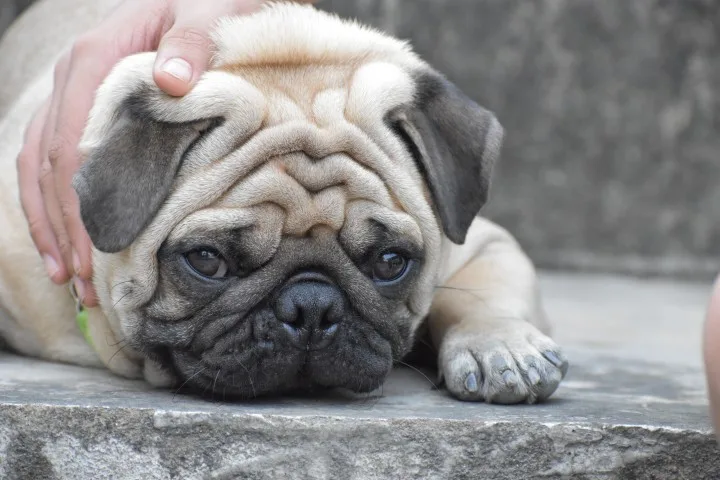 Although a Pug has short fur and is a small dog, this is not a hypoallergenic dog. A Pug has a thick double coat that can produce a tremendous amount of shedding and dander.
Although a Pug has short fur and is a small dog, this is not a hypoallergenic dog. A Pug has a thick double coat that can produce a tremendous amount of shedding and dander.
If you suffer from pet allergies, a Pug is not the right choice for you.
If you are determined to get a Pug, you should try to adopt a black Pug even with pet allergies. This coloration only has a single-layer coat which can significantly reduce shedding and dander.
Unfortunately, black Pugs are rare to find, but they are still accepted in the AKC show ring.
Routine grooming and bathing can further help minimize shedding in your Pug, but allergy sufferers are likely to experience ongoing symptoms with this dog breed.
Do Pugs Have Thick Fur?
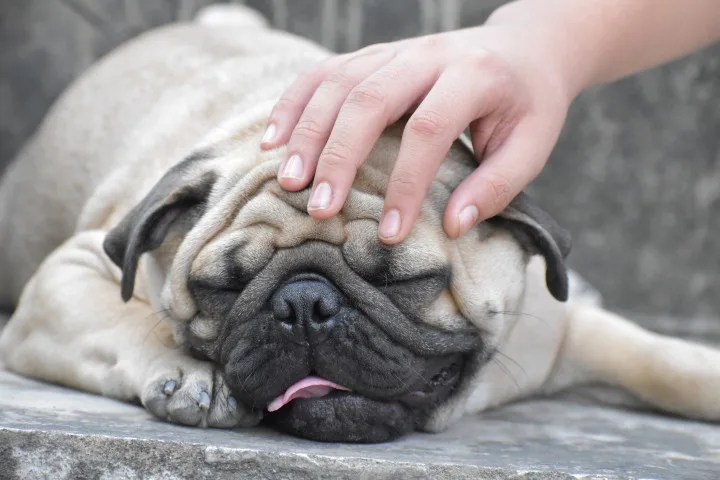 Despite being small dogs with short hair, pugs have amazingly thick fur. This characteristic is largely because the Pug has a double coat.
Despite being small dogs with short hair, pugs have amazingly thick fur. This characteristic is largely because the Pug has a double coat.
The top coat is coarse and rough and used to protect the Pug from all weather conditions. Under the top coat is a smooth and downy undercoat.
The undercoat is used to keep the pet warm in the winter and cool in the summer. With double the fur layers, a Pug’s fur is astonishingly thick.
This feature leads to increased shedding, which means a Pug is not a hypoallergenic dog.
Do Pugs Shed?
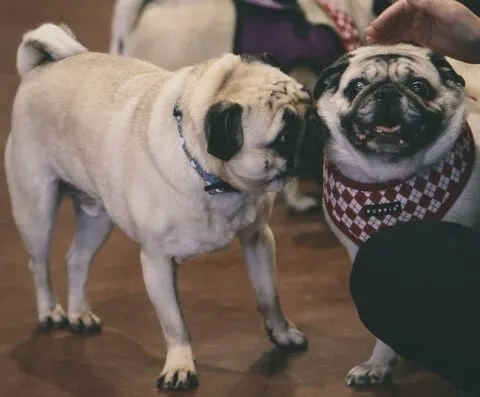 Pugs are not hypoallergenic dogs, and as such, shed. In fact, for such a small dog, Pugs are very prolific shedders, largely due to their double coat.
Pugs are not hypoallergenic dogs, and as such, shed. In fact, for such a small dog, Pugs are very prolific shedders, largely due to their double coat.
Pugs will shed year-round, and expect to find hair on your clothing, floors, furniture, and drapes. While shedding is consistent throughout the year, expect a particularly h wavy shed twice per year.
Usually, the heavy shedding season coincides with changing seasons. During these heavy sheds, a Pug is said to “blow” its coat.
This term refers to the Pug losing its insulating warm fur to prepare for the summer months and gaining its wooly warmth as it prepares for colder temperatures in the winter.
During heavy shedding periods, expect to groom your dog daily. These heavy shedding periods usually last about two weeks or until your Pug has entirely replaced its fur.
Does A Pug’s Color Determine How Much It Sheds?
Pugs come in multiple colors, including apricot, fawn, silver fawn, or black coats. Surprisingly, the color of the Pug’s coat does impact how much your Pug will shed.
Only the black Pugs will have a single coat, while the other colors have the standard double coat.
The single black coat means that the dog will have a thinner coat, thus less fur to shed. If you are concerned with excessive shedding or high dander production, be sure to choose a black Pug to adopt.
Although a black pug is more desirable for allergy sufferers, this is also a scarce color to find. The AKC will recognize black coats in Pugs.
How Much Grooming Do Pugs Require?
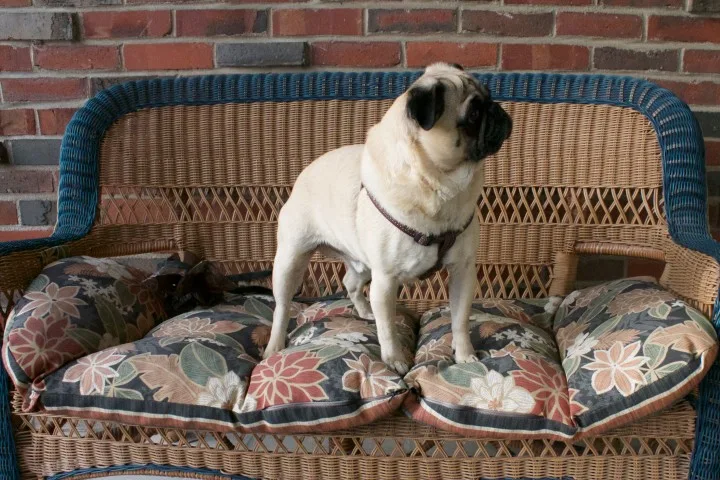 Pugs have thick fur and shed more than your average dog. To keep up with their constant fur turnover, they need to be brushed and groomed. Using a comb or a slicker, brush your Pug about three times a week.
Pugs have thick fur and shed more than your average dog. To keep up with their constant fur turnover, they need to be brushed and groomed. Using a comb or a slicker, brush your Pug about three times a week.
Brushing your dog will help release loose and dead hairs and also help keep their fur naturally oiled from oils produced on the skin.
Bathe your Pug reasonably regularly, about once a month. Washing your dog will help remove airborne allergens from your pet’s fur, as well as wash away built-up dander and loose fur.
Always use a natural, moisturizing shampoo to keep your pet’s natural oils in the skin. Washing your pet too frequently can dry the fur, which could lead to increased shedding and dander production.
Will Grooming Help Relieve Allergies?
Not only is routine grooming healthy for your dog, but it is a great way to help control pet allergies.
The more you keep up with routine brushing and bathing, the more you will be able to capture loose and dead fur before it has a chance to circulate in your home, creating potential allergens.
Further, routine grooming is a great way to keep your dog healthy and happy. When your dog’s skin and coat are healthy, it is less necessary to turn over old hairs with new hairs constantly.
When turnover is reduced, shedding is also reduced due to healthy oiled fur, which can help mitigate allergy symptoms.
How Can I Tell If A Pug Will Trigger Allergies?
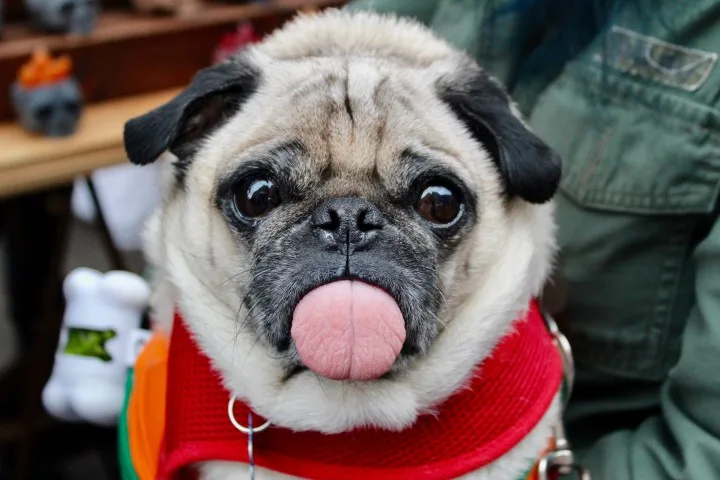 Pugs are not hypoallergenic and shed a moderate amount. There is a high likelihood that a Pug could trigger your pet allergies if you regularly have pet fur and dander in your home.
Pugs are not hypoallergenic and shed a moderate amount. There is a high likelihood that a Pug could trigger your pet allergies if you regularly have pet fur and dander in your home.
It is a good idea to spend time with a Pug before adoption.
If possible, try fostering a Pug. Fostering is a great way to get the experience of owning a pet and having it live in your home.
Fostering not only gives you a good idea of how much of an impact a Pug’s dander and fur will have on your allergies, and it also helps provide a pup an excellent and comfortable home until it is adopted.
You never know; you could end up as a foster fail and meet your new best friend.
What Should I Look For In Hypoallergenic Dogs?
Suffering from pet allergies dramatically limits the types of dog breeds that you can adopt. When looking for a dog, first look for dogs considered hypoallergenic.
These dogs tend to shed much less than the average dog and produce less dander. Remember that no dog is completely hypoallergenic, but having dogs that shed less frequently is less likely to trigger an allergic response.
Next, look for smaller dogs. The smaller the dog, the less fur the animal will produce. Even though a larger dog may be a light shedder, consider that there is more body area and more fur to shed.
The only exception to this general rule is when you are choosing a large, hypoallergenic dog, such as Standard Poodles or Afghan Hounds. For severe allergy sufferers, look for small, hypoallergenic dogs.
Can Pugs Have Allergies?
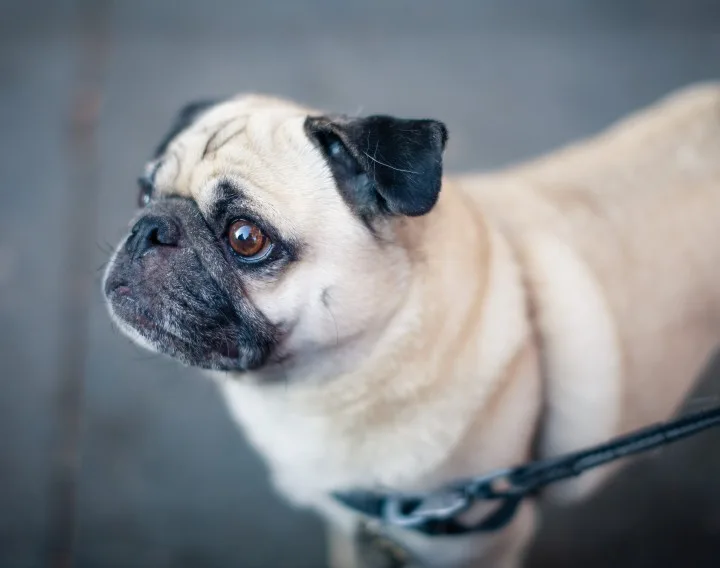 Allergies not only impact humans. Dogs can get allergies too, and the symptoms are oddly similar to humans.
Allergies not only impact humans. Dogs can get allergies too, and the symptoms are oddly similar to humans.
A pug with allergies may have a runny nose, cough, or watery eyes. Pets may have skin irritation or have patches of missing fur.
Several triggers can cause allergies in pets, and Pugs seem to be particularly likely to develop allergies. Some common allergens for Pugs include:
- Food including Treats and People Food
- Materials (Plastics, Toys, Fabrics)
- Environmental Allergens like Smoke, Fragrances
- Seasonal Pollens and Spores
- Dust and Other Pet Dander
If you suspect that your Pug is suffering from allergies, take your pet to the veterinarian. A veterinarian will be able to diagnose allergies and prescribe recommended treatment successfully.
It may be possible to get your dog on prescription allergy medications to help reduce or even eliminate allergy symptoms in your Pug.
For dogs, many prescription allergy medications are easy to administer, with an oral pill taken once or twice a day. Some dogs only need allergy medication intermittently as symptoms worsen with changing seasons.
Related Questions
Do Pugs have breathing trouble?
One of the defining features of the Pug is the short, squished nose. This shortened nose is actually a physical feature that many dogs share.
Brachycephalic dogs, or dogs with a shortened nose, often have difficulty breathing due to a small windpipe. Other brachycephalic dogs include some Pit Bulls and Boxers.
Pugs, in particular, may have trouble breathing, especially if they become overheated or overweight. Further, if they develop problems with an elongated soft palate, their small airway could become impeded, blocking the trachea.
With a brachycephalic dog, always be sure to monitor your pet in high heat or high humidity closely.
Keep a close eye on your dog with physical exercise and always use caution when transporting your dog via airplane, where changing pressure could further aggravate the windpipe and trachea.
Are Pugs good apartment dogs?
Due to their small size and relatively low energy level, the Pug makes an excellent apartment dog.
This little dog is happy with just a short outing for exercise and doesn’t demand much in the way of mental stimulation.
The dog is personable and friendly and generally does well in social settings. Although it may be the largest of the toy breeds, this little dog is just fine living in an apartment.
Plus, Pugs are highly adaptable, making them well suited to live in a range of environments.
Our team is composed of pet care professionals, veterinarians, and pet owners. To date, we’ve conducted thousands of hours of research to publish the most accurate pet information.
Most of the writers on our site are vets with 10+ years of clinical experience, ranging from small practice, to equine practice, academia, and surgery. Our goal is to help every pet owner get the information they seek about their dear companions.

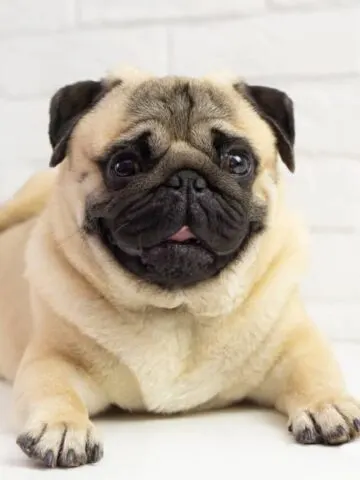

Leave a comment
You must be logged in to post a comment.